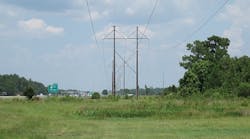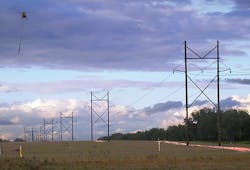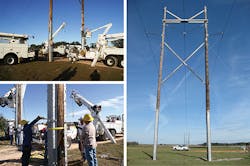Complexity of Powering Central Florida’s Future
It is not uncommon for a power line upgrade project to require innovative engineering. It also is not unusual for such a project to involve complex permitting and community relations issues. But throw in a large amount of civil and environmental engineering, permitting and construction work along with the management of numerous subcontractors over a six-year construction schedule — all while working with a live line — and one can begin to understand the degree of difficulty the Orlando Utilities Commission was facing when it engaged Black & Veatch to engineer and manage the upgrade of its 46-mile (74-km) Taft-Lakeland transmission line.
The original 230-kV Taft-Lakeland transmission line began operating in 1981. At the time, it carried the Orlando Utilities Commission’s share of Lakeland McIntosh Unit 3’s output (134 MW) to the utility’s Taft substation south of Orlando, Florida, U.S. Of course, three decades ago it was impossible to predict how Walt Disney World and the overall expansion of the tourism industry would kick-start population growth in Central Florida; today, it is plainly obvious. The population of Greater Orlando has nearly tripled to approximately 2.1 million since 1981, while the Lakeland area population has almost doubled to approximately 623,000 during the same period.
With population growth creating an ever-greater demand for power, the Taft-Lakeland line became a key component of the Central Florida transmission grid: Tampa Electric purchased a portion of the line and added the Lake Agnes and Osceola substations to deliver power to Walt Disney World. In addition, the Kissimmee Utility Authority used the Taft-Lakeland line to integrate its Cane Island plant into the Central Florida grid.
By the early 2000s, with the line experiencing overloads, it became abundantly clear upgrades would be needed to meet Florida Reliability Coordinating Council and North American Electric Reliability Corporation standards. In 2006, the Florida Reliability Coordinating Council, Florida Central Coordinated Study and Florida Public Service Commission worked with the Orlando Utilities Commission to upgrade the entire Taft-Lakeland line to ensure a safe and reliable source of power for Central Florida.
Facing Complex Challenges
In addition to being vital to the economy of Central Florida, the Taft-Lakeland line passes through one of the most ecologically sensitive areas in the state. This region includes pastureland, citrus groves and sensitive swampland, most of which is within the 50,000-acre (20,234-hectare) Green Swamp Wildlife Management Area that the state of Florida has designated as an area of critical concern.
All of these factors raised the stakes for the Orlando Utilities Commission. The utility knew the project would challenge its entire organization and it could not miss a step. Clearly, success would rely on building a solid team that possessed all the right skill sets for the job. They would have to foster a climate in which all parties communicated with each other easily and frequently to anticipate problems. They would have to pay attention to every minute detail, and they would have to be agile enough to react immediately to every new challenge that came along. No shortcuts. No corners cut.
To oversee this daunting effort, the Orlando Utilities Commission turned to Black & Veatch, with which it had a long-standing working relationship. Because of that association, Black & Veatch was intimately familiar with Orlando Utilities Commission’s technical standards and internal processes, which put the firm in a position to both help develop the project team and aid the team in making critical decisions as situations arose.
The final Orlando Utilities Commission project team included Black & Veatch as the overall project manager, one law firm, three construction contractors and four technical consultants. The team did not know it at the time, but this was just the beginning. As the project unfolded, there would be additional engineering and environmental complexities — and many new players. In fact, over the life of the project, the team would interact with five federal and state agencies, four local government bodies and each other, of course.
The project team’s capacity to react to sudden challenges was tested right out of the chute when it had to accommodate the expansion and widening of Interstate 4, which parallels the line for most of its length. In fact, the new I-4 corridor had expanded into the Orlando Utilities Commission’s right-of-way, requiring the team to modify the alignment of the line and acquire additional real estate just as work was about to start.
Planning a Six-Year Project
Given the layout of the line and availability of outages required for construction, the team divided the project into four distinct phases with a six-year construction schedule. Each line segment was then treated as a separate effort under the umbrella of the needs — both technical and permitting — of the entire line. As such, the project involved several tasks:
•Reconductoring the line to carry 2000 A continuous and 2400 A emergency (summer rating).
•Adding access roads and structuring working pads sufficiently to allow the equipment necessary for live-line maintenance along this critical corridor.
•Performing environmental work in concert with recognized standards and good stewardship.
•Meeting the upgrade construction schedule for each line segment: Lake Agnes to Osceola in 2007-2008, Taft to Cane Island Tap in 2008-2009, Cane Island Tap to Osceola in 2009-2010 and Lake Agnes to McIntosh Unit 3 in 2012-2013 (the delay of the final segment was intentional and in keeping with the overall project plan).
Maneuvering the Regulatory Thicket
Because the transmission line was originally certified by the state of Florida under the Power Plant Siting Act, all line modifications and construction impacts had to be submitted for approval to numerous agencies within the state as well as to the U.S. Army Corps of Engineers. This meant there were lengthy, numerous and often unexpected permit applications.
From the outset, the project team — advised by environmental consultant Golder Associates — was in constant communication with a wide range of federal, state and local regulatory bodies: U.S. Army Corps of Engineers, U.S. Fish & Wildlife Service, Florida Department of Environmental Protection, Florida Fish and Wildlife Conservation Commission, Hilochee Wildlife Management Area, Polk County, Orange County, Osceola County and Reedy Creek Improvement District, a governmental body created in 1967 to oversee development by the Disney companies.
Bracing for Change-Out
With the team unaware of the environmental complications that lay ahead, they focused on selecting a conductor that would meet the new load requirements and reviewing all 279 structures along the line to determine which would have to be redesigned or rebuilt to handle the new conductor. After conducting light detection and ranging (LiDAR) and ground surveys, the team selected a 1272-kcmil aluminum conductor, steel-supported/trapezoidal-shaped wire (ACSS/TW) conductor for the upgrade.
Installing the new conductor would nearly double the capacity of the original 954-kcmil aluminum conductor, steel-reinforced/aluminum-clad wire (ACSR/AW) conductor from 1050 A to 2000 A continuous; provide a higher maximum operating temperature of 250°C (482°F) compared with 100°C (212°F) previously; sag less than ACSR under maximum loading conditions; and offer excellent self-damping characteristics. Although ACSS/TW conductor was heavier than the original conductor, it was only slightly larger, so the team believed most of the existing structures could be reframed and salvaged, benefiting both the project’s costs and schedule.
However, engineers soon discovered crossarm members had deteriorated on a number of the existing wood H-frame structures and would have to be replaced. This led to the installation of heavier knee braces, conversion of the two outside phases to braced posts as well as the conversion of the inside phase to a V-string configuration.
Raising Structures
In 51 cases, engineers determined simply reconfiguring the structures would not be enough. When the line was operated at 250°C, line sag would breach National Electrical Safety Code ground clearance limits. Raising those structures to handle the sag was the best option and engineers decided to employ PhaseRaisers to accomplish it. With PhaseRaisers, the single- or double-pole structure is first externally braced near the base and then the uprights are cut and jacked to the desired new height.
Several lattice structures required reinforcement of the base sections to carry the additional loads. This was accomplished either by change-out of existing members for larger ones or adding additional lattice members.
Fortunately, most of the existing foundations proved adequate for the upgraded line, even where structures were raised or reframed. In a few cases, where engineers deemed the foundation capacity insufficient, they replaced both the structure and the foundation. For example, where wood three-pole deadends were replaced with steel poles, engineers chose drilled-pier foundations with anchor bolts for the base plates.
Overall, engineers replaced 35 existing wood structures with new steel structures and raised eight existing lattice towers to meet National Electrical Safety Code clearance limits. One further complication was the existing towers were double circuit, which required one of the circuits to be removed, placed on temporary poles and re-energized prior to taking an outage on the primary circuit. The primary circuit was floated while the rework on the tower was completed.
Simply Managing Complexity
As anyone familiar with transmission line work knows, this entire process required extraordinary planning, design and construction sequencing. That it went off flawlessly was a result of extraordinary teamwork and the ability to keep it simple. That is, the OUC team had to manage complexity without making things more complicated. Of course, that does not mean it was easy. It took a great team continually communicating and collaborating with each other and with outside parties — and a lot of hard work — to make it happen.
Charles H. Easterling is manager of transmission construction and system maintenance at Orlando Utilities Commission, where he has worked for 25 years. Easterling earned a bachelor’s degree in electrical engineering from Georgia Institute of Technology in 1991 and has been a registered professional engineer since 1999.
Hrishikesh P. Moghe is a project manager in the Houston, Texas, office of Black & Veatch, where he oversees power-delivery projects. Moghe holds a BSCE degree from Mumbai University and a MSCE degree from Louisiana Tech University. He is a registered professional engineer.
Editor’s note: A follow-up article in August will focus on the environmental and permitting aspects of this project.





